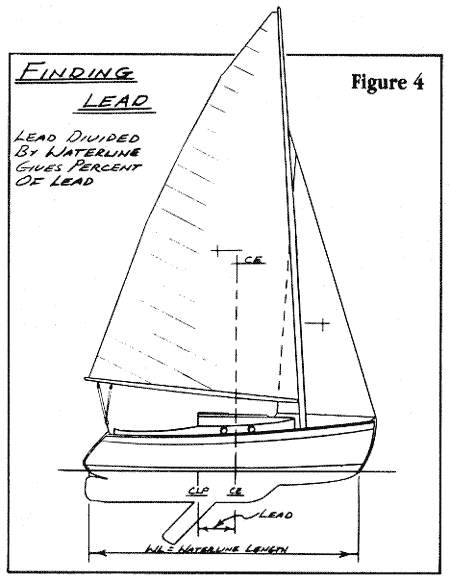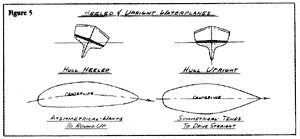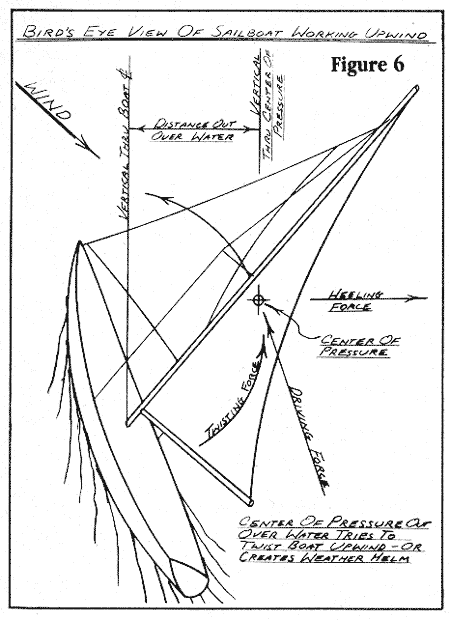|
Helm Control
The Delicate Balance
By Dave Gerr illustrations by the author
from Small Boat Journal #60 May. 1988
Sailors talk endlessly about the feel and
balance of the helm. Often, you'll
hear a boat described as "hard mouthed,"
or "balanced," or "light helmed," or as
having too much weather helm or lee
helm. These terms refer to the amount of
steering force required to hold a boat on
course on various points of sail and in
differingwind strengths, and they directly
affect how comfortably or - efficiently a
boat sails. But what exactly is weather
helm or lee helm? And what can you do to
control it?
The answers are both simple and complex — simple because the effect is very
clear, and complex because many factors
interact to create that effect. Weather
helm is the force needed to counteract
the vessel's tendency to round up into the
wind. On a tiller-steered boat, weather
helm means you have to hold the tiller up
to windward ("to weather") to maintain
your course. On a wheel-steered boat, it
means turning the wheel to leeward.
In moderation, weather helm is highly
desirable. One very important benefit is
this acts as a sort of dead-man's brake. If
you suddenly let go of the tiller — say, in
an emergency — it will swing amidships
and your craft will head up and, ideally,
lie to, in irons.
Another important benefit of moderate
weather helm is that it improves upwind
performance. The slightly angled rudder
deflects the water flow in much the same
way that a curved airplane wing deflects
airflow, thus producing lift and reducing
leeway.
Too much weather helm is not at all
desirable, however. A vessel with excessive weather helm is called "hard
mouthed." It is tiring to sail because
you're constantly fighting the tiller or
wheel and it slows the boat down. A
rudder over more than 10 or 19 degrees
ceases to act as an aid in increasing lift and
starts behaving like a brake.
A boat with helm feel so light that the
merest nudge will swing the tiller widely
might seem at first like the ultimate in
fingertip control. But without the slight
continuous pressure on the rudder generated by moderate weather helm, you
can't really sense where your boat is
going. I once owned a boat with neutral
helm. The minute you glanced away
she'd wander off course. A helm with
feather-light touch like this simply
doesn't give you the tactile feedback you
need to steer under good control, by the
seat of your pants.

Least desirable is lee helm. A craft with
lee helm requires her skipper to hold the
tiller to leeward or turn the wheel to
windward to keep her on course. Not only
does this hinder upwind performance,
but such a boat has no dead-man's brake.
If you release the tiller, the vessel will fall
off and, quite possibly, sail you into
serious trouble. If you're sailing close
hauled with the sheets dealed, for instance, you could end up broadside to the
wind with the sails in flat — conditions
that invite knockdowns or even capsizes.
Helm Factors
What are the factors affecting helm or
balance? One of the most significant is the
relationship of the sail plan to the underwater area of the boat. Essentially, a boat
that has weather helm weathercocks into
the wind like a wind vane. If the sails'
center of pressure is too far aft relative to
the hull's center of pressure, the boat will
have too much weather helm. If, on the
other hand, the center of pressure of the
sails was too far forward, the boat will
have lee helm, causing the stern, not the
bow, to point into the wind.
In practice, all this is complicated by
the fact that a boat's underbody is anything but a plain flat shape. In fact, it is
essentially impossible to find the actual
center of water pressure since it moves
around in response to course changes,
angles of heel, speed through the water,
sea state, and a whole host of unpredictable factors.

For estimating the hull's center of pressure, most designers use the following
simple method. Trace the profile (side
view) of your Jaunty Jane's hull underbody — every part of the boat below the
waterline, including rudder and centerboard — and cut this shape out on a piece
of cardboard. Balance the cardboard cut-out across the edge of a ruler perpendicular to the waterline. Naval architects call this imaginary center the center of lateral
plane (CLP), also known as the center of
lateral resistance.
The next step is to figure the areas and
centers of effort (CE) of the various sails
and combine them to locate the total center of effort of the entire sail plan. Let's say
Jaunty Jane is a catboat with a leg-o-
mutton sail. Ignore the roach, and her sail
is an ordinary triangle. The area is then
one-half the base times the height of the
triangle. To find the center of effort, make
a tick mark exactly half way down the luff
and halfway down the imaginary leach
(the straight line between clew and
head). Draw lines from these tick marks
across to the corners of the sail directly
opposite — luff to clew, leach to tack. The
center of effort of this sail is where these
two lines cross (Fig. 1).

Gaff Calculations
If Jaunty Jane were a gaff-rigged catboat, draw a line from the clew to the
throat, dividing the sail into two triangles.
You can then find the area of each triangle
and the center of each triangle, just as
before. Adding the areas gives the total
area.
Finding the combined center of effort
is a bit more complicated. Draw a line
connecting the two center points of each
triangle. Then from the center point of
each triangle, draw another line perpendicular to the first (Fig. 2). These two
lines should project from the center
points in opposite directions. The lengths
of these perpendicular lines are proportional to the area of the opposite triangle.
For instance, if the lower triangle was 55
square feet and the upper triangle was 46
square feet, you could measure off 55
eighths of an inch (6-7/8 inches) on the upper perpendicular and 46 eighths of an
inch (5-3/4 inches) on the lower perpendicular. Now, draw a line connecting the
ends of the two perpendiculars. The point
at which this line crosses the original line
— the line directly between the two triangle centers — is the center of the full
gaff sail.

Keep in mind that this is just an approximation used by designers to estimate the
true center of pressure of the wind on the
sails. As with the center of pressure on the
hull, the actual center of pressure on the
sails changes with the angle of heel, sail
shape and trim, wind speed, and many
other factors. The most powerful computer known wouldn't be able to reliably
pinpoint it.
This same approach, determining the
total center of effort, works for any combination of sails. If Jaunty Jane had been a sloop, the second triangle would be the
area of the foretriangle* instead of the top
half of a gaff sail. If you were figuring a
ketch or yawl, simply find the combined
area of the main and foretriangle and
then, taking their total area and total center, combine them with the area of the
mizzen using the same method (Fig. 3).
In fact, you could go on with this method
to figure the areas and center of effort on
any boat, with any number of sails, right
up to a ftill-rigged ship.
*By convention, the area of the foretriangle is the area
of the triangle made by the headstay, the forward face
of the mast — up to the intersection of the headstay
— and the distance from the forward face of the mast
along the deck to the headstay fitting at the bow.
Once you have the location of the center of lateral plane and the center of effort,
the last step is to see how they relate to
each other. To do this, drop a vertical line
from the CE down to the waterline. Measure the distance between them and divide that distance by the full waterline
length (Fig. 4). Designers call this the
lead (pronounced "leed").
The confusing thing here is that almost
every boat ever built should have the CE
ahead of the CLP. Why is this? Well, remember the CE and CLP are only imaginary approximations on flat surfaces of
the true centers of pressure on the sails
and on the hull underbody. The real centers, if we could find them, are much
different. Fortunately, experience over
the years has provided designers with
guidelines for estimating the amount of
lead (where these imaginary centers
should be in relation to one another) so
that their boats will behave properly:
Percent of Lead
| Schooner |
7%-12% |
| Ketch |
11%-l4% |
| Yawl |
12%-15% |
| Sloop |
13%-17% |
If, for example, Jaunty Jane had an 18
foot waterline and was an average sloop,
her lead should be about 13 percent, or
her CE should fall 2.7 feet ahead of her
CLP (15% x 18 feet = 2.7 feet). These
numbers are average ranges for most vessels, and with a little judgment, you won't
go wrong using them, provided you take
into account other considerations.

Figure 5 (click image to enlarge)
Hull Factors
First, hull shape can greatly affect the
amount of weather helm a boat has when
heeled. This is because the hull presents
an asymmetrical shape to the water as it heels, tending to make the boat round up
even more than the simple fore and aft
location of the centers of pressure alone
would indicate (Fig. 5). In generaly, anything that tends to increase hull form stability increases weather helm when the
boat heels. For instance, a wide hull with
a broad transom and hard bilges will become very asymmetrical and cause more
weather helm when heeled. On the other
extreme, a narrow double ender with
slack bilges will maintain its symmetry and
cause less weather helm. If Jaunty Jane
were a sloop with a wide hull and hard
bilges, you'd be wise to use the larger
amount of lead called for in the table to compensate for the additional weather
helm generated by the heeled hull shape.
Similarly, a tall rig creates more
weather helm than a short one. This is
because the center of the sails is actually
way out over the water to leeward when
the boat is heeled over. The pressure of
the wind is, for all intents and purposes,
acting at this point as if a giant caught hold
of a long lever (the mast) and twisted the
boat to windward (Fig. 6). Again, for any
of the above lead categories, you would
choose from the higher end of the recommended leads for tall-rigged craft and
from the lower end for shorter-rigged vessels.

In fact, if all the factors indicated it, you
might drop down a bit or go up a bit from
the recommended leads. Say your Galloping Gazelle was a narrow slack-bilged
double-ended sloop with a low rig. These
factors all indicate that her hull will not
generate much additional weather helm
due to heel. Thus, for a boat like this, you
ought to consider using not the 13 percent lead indicated on the low end of the
table's recommendations for sloops but
perhaps even 12 percent.
Put this all together and you can determine the effect of adding more sail area,
how to change your boat from, say, a
sloop to a yawl without adversely affecting performance, and where to locate a
centerboard or leeboards in a boat being converted to sail. Plus, you can gain insight into the delicate balance of factors
that affect the way your boat sails, and
your helm feels.

DAVE GERR is a naval architect specializing in small craft design. His book Pocket
Cruisers for the Backyard Builder was recently published by InternationalMarine.
|

